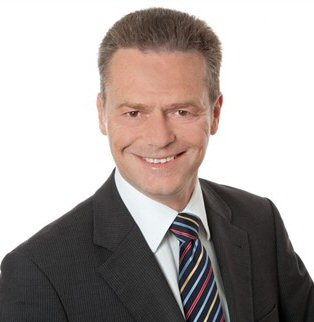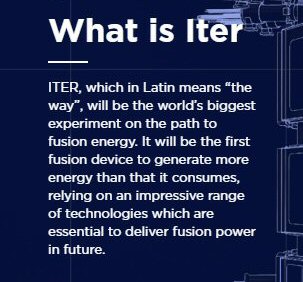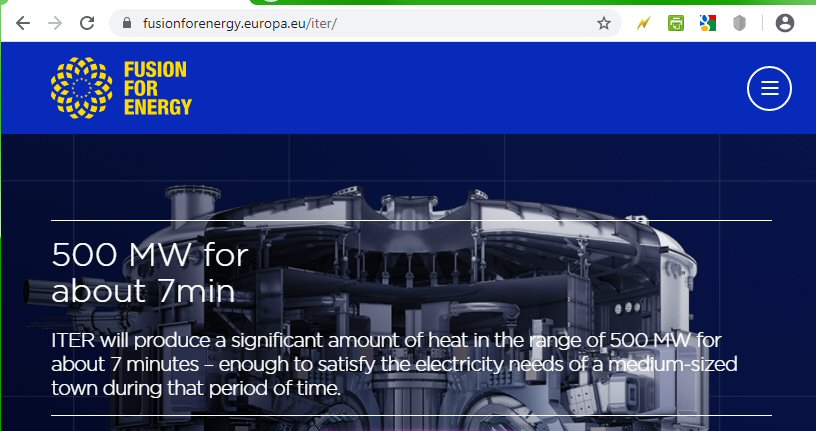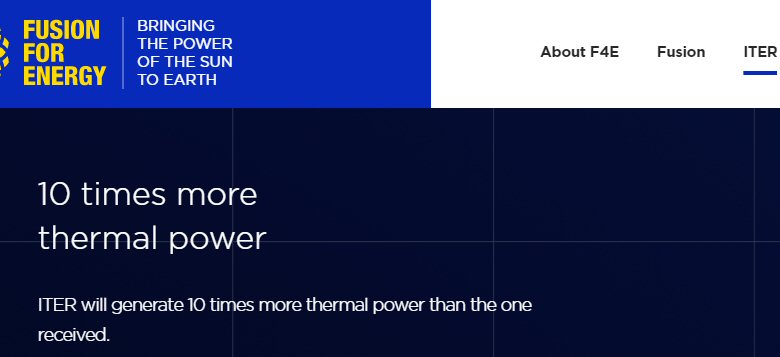39. False Fusion Claims by ITER European Domestic Agency

Johannes Schwemmer, Director of Fusion for Energy
Return to ITER Power Facts Main Page
By Steven B. Krivit
July 23, 2020
The European ITER domestic agency known as Fusion for Energy recently published new false claims about the International Thermonuclear Experimental Reactor project known as ITER. The project will cost taxpayers from 35 nations $45 billion.
The reactor is not designed to produce electricity. However, if it works as planned, it will demonstrate an important scientific achievement: a fusion plasma that has more thermal power than the thermal power used to heat the fuel.
Practically speaking, however, this means that the reactor will produce about zero net power output and will not demonstrate that fusion is a viable energy source despite the hype.
Even though Johannes Schwemmer, the director of the agency, knows how to make accurate and honest claims about the ITER reactor, his organization published a new set of inaccurate, misleading, and exaggerated claims several months ago in three places on the Fusion for Energy ITER Web page.
When fusion scientists talk to one another, they all understand the objective of the ITER project. But when they are communicating the project’s goals to the public, some scientists make false and misleading claims about ITER.
In his own words, from his Nov. 9, 2018, letter to me, Schwemmer wrote that the accurate way to represent the primary objective and goal of ITER is to “ensure that there is no possible misunderstanding on the ITER energy gain of 10 – [that it is] linked only to the plasma and not to the energy balance of the overall ITER plant.”
Yet his organization does otherwise.

CLAIM #1
CLAIM #1: CURRENT STATEMENT
“ITER, which in Latin means ‘the way,’ will be the world’s biggest experiment on the path to fusion energy. It will be the first fusion device to generate more energy than that it consumes.”
NOTE: This is false: The device itself is expected to demonstrate zero net power; see the power values in detail below.
An accurate statement would be “ITER, which in Latin means ‘the way,’ will be the world’s biggest experiment on the path to fusion energy. It will be the first fusion device to produce a fusion plasma with more thermal power than the heating power injected into the plasma.”
CLAIM #2 CURRENT STATEMENT
“500 MW for about 7 min – ITER will produce a significant amount of heat in the range of 500 MW for about 7 minutes – enough to satisfy the electricity needs of a medium-sized town during that period of time.”
NOTE: This is dishonest and misleading: If ITER were designed to convert the net thermal power output to electricity, there wouldn’t be enough net power to produce 1 Watt. Based on the ITER design, the overall reactor will produce 686 MW gross thermal output. If this were converted to electricity, it would result in 274 MW gross electrical power and negative 26 MW net electrical power.
An accurate statement would be “A 500 MW plasma for about 7 min – ITER will produce a fusion plasma with a significant amount of thermal power in the range of 500 MW for about 7 minutes.”

CLAIM #2
CLAIM #3 CURRENT STATEMENT
“10 times more thermal power – ITER will generate 10 times more thermal power than [that] received.”
NOTE: This is misleading. To be accurate, all power claims must clearly be associated with the plasma.
An accurate statement would be “ITER will produce a fusion plasma with 10 times more thermal power than the heating power injected into the plasma.”

CLAIM #3
In other news, the European Parliament just approved another €5 billion for the ITER project.
Fusion for Energy Governing Board (July 23, 2020)
Beatrix Vierkorn Rudolph — Chair of the Governing Board of Fusion for Energy
Friedrich Aumayr — Director, Institute of Applied Physics TU Wien (Vienna University of Technology), Austria
Daniel Weselka — Head of Unit, Federal Ministry for Science and Research, Austria
Ir Alberto Fernandez Fernandez — Nuclear Attaché to DG Energy, FPS Economy, Belgium
Eric Van Walle — General Manager, SCK.CEN, Belgium
DSC Troyo Dimov Troev — Head of Research Unit of the Association Euratom-INRNE, Bulgaria Academy of Sciences, Bulgaria
Tonci Tadic — Division of Experimental Physics, Laboratory for Ion Beam Interactions, Rudjer Boskovic Institute, Croatia
Stjepko Fazinic — Division of Experimental Physics, Laboratory for Ion Beam Interactions, Rudjer Boskovic Institute, Croatia
Anastassios Yiannaki — Director of Reactor Services Division Nuclear Research Institute Rež, Cyprus
Radomir Panek — Institute of Plasma Physics of the CAS, Czech Republic
Ing. Ladislav Vála — Senior Researcher & Project Manager Centrum výzkumu Rež s.r.o. (Research Centre Rež), Czech Republic
Tomas Midtgaard — Senior Advisor, Danish Agency for Science, Technology and Ministry of Higher Education and Science, Denmark
Volker Naulin — Head of Section, Plasma Physics and Fusion Energy, Department of Physics, Technical University of Denmark, Denmark
Rein Kaarli — Advisor, Department of Research, Ministry of Education and Research, Estonia
Madis Kiisk — Director, Institute of Physics, University of Tartu, Estonia
Tuomas Tala — Head of Research Unit of the Euratom-Tekes Association, VTT Technical Research Centre of Finland, Finland
Kari Koskela — Senior Advisor, Centre for Economic Development, Transport and the Environment for Southeast Finland, Finland
Bertrand Bouchet — Managing Director for European Affairs CEA- International Relations Division, France
Maria Faury — Director of international affairs and large research infrastructures, CEA – Fundamental research division, France
Harald Bolt — Forschungszentrum Juelich (VS-U), Germany
Michael Stötze — Head of Division “Fusion Research: FZJ, HZDR, HZB, IPP” Federal Ministry of Education and Research, Germany
Stubos Athanasios — Director of the Institute of Nuclear and Radiological Sciences and Technology, Energy and Safety. National Centre for Scientific Research Demokritos, Greece
Mergia Konstantia — Director of Research, INRASTES, NCSR Demokritos Scientist in charge of Greek Fusion Technology Program for Demokritos, Greece
Siegler Andras — Senior Advisor National Research Development and Innovation Office Hungary, Hungary
Gábor Veres — Wigner Research Centre for Physics, Hungarian Academy of Sciences, Hungary
Miles Turner — Physics, Dublin City University, Ireland
Paul Shortt — Dept. of Communications, Climate Action and Environment, Ireland
Ing Aldo Pizzuto — Head of Research Unit Euratom-ENEA Association, ENEA Frascati, Italy
Eugenio Nappi — Vice President INFN, Italy
Massimo Garribba — Director of Nuclear energy, safety and ITER, DG Energy European Commission, EURATOM
Dmitrijs Stepanovs — Ministry of Education and Science of the Republic of Latvia, Latvia
Hab Andris Sternbergs — Institute of Solid State Physics, University of Latvia, Afghanistan
Sigitas Rimkevicius — Head, Laboratory of Nuclear Installation Safety Lithuanian Energy Institute, Lithuania
Stanislovas Žurauskas — Deputy Head, Science and Technology Division, Ministry of Education and Science, Lithuania
Leon Diederich — Conseiller de Gouvernement, Ministere de l’Enseignement superieur et de la Recherche, Luxembourg
Gaston Schmit — Conseiller de Gouvernement, Ministere de l’Enseignement superieur et de la Recherche, Luxembourg
Ian Gauci Borda — Associate Consultant, Malta Council for Science and Technology, Malta
Karl Montebello — Policy and Strategy Executive, The Malta Council for Science and Technology, Malta
Jeannette Ridder-Numan — Senior policy advisor/deputy head for Science and Humanities and International Affairs, Ministery of Education, Culture and Science, Netherlands
Marco de Baar — Director Nuclear Fusion Programme DIFFER institute, Netherlands
Lukasz Ciupinski — Scientific Expert Materials Design Division, Faculty of Materials Science and Engineering Warsaw University of Technology, Poland
Paulina Styczen — Principal Expert, Department of Strategy, Ministry of Science and Higher Education of the Republic of Poland, Poland
Carlos Varandas — Instituto de Plasmas e Fusao Nuclear, Portugal
Teresa Ponce de Leão — President of LNEG, Portugal
Florin Buzatu — Director-General, Institute of Atomic Physics, Romania
Teddy Craciunescu — National Institute of Lasers, Plasma and Radiation Physics NILPRP Bucharest-Magurele, Romania, Romania
Stefan Matejcik — Faculty of Mathematics, Physics and Informatics, Comenius University, Slovakia
Jozef Pitel — Research Scientist, Institute of Electrical Engineering, Slovak Academy of Sciences, Slovakia
Jože Duhovnik — Dean, Faculty for ME, University of Ljubljana, Slovenia
Igor Lengar — Jozef Stefan Institute, Reactor Physics Division, Slovenia
Joaquín Sánchez Sanz — Director de Laboratorio Nacional de Fusion Centro Investigaciones Energéticas, Medioambientales y Tecnológicas (CIEMAT), Spain
Carlos E. Martínez Riera — Ministry of Sciencie, Innovation and Universities, Spain
James Drake — Division of Fusion Plasma Physics, The Royal Institute of Technology KTH, Sweden
Pär Omling — Department of Solid State Physics, Lund University, Sweden
Xavier Reymond — State Secretariat for education, Research and Innovation, International Cooperation in Research and Innovation, Switzerland
Ambrogio Fasoli — Director Centres de Recherches en Physique des Plasmas CRPP Ecole Polytechnique Federale de Lausanne EPFL, Switzerland

